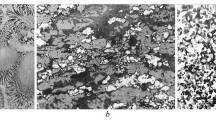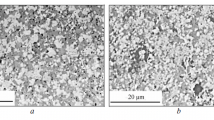The paper examines how to increase the reliability and service life of dynamic equipment parts operating at high speeds, loads, and temperatures and in corrosive, abrasive, and other environments. Increase in the thickness of the high-hardness layer for friction parts subjected to abrasive and other types of wear is a relevant problem. The research findings and the method developed for protecting steel products against wear by applying a quasimultilayer wear-resistant coating (QWC) onto the wear surface by electrospark deposition (ESD) and increasing the thickness of the high-hardness layer are described. Based on metallography, hardness measurement, electron microprobe analysis, and X-ray diffraction, the regularities of producing the QWC with alternating alloying electrodes by sequential ESD of carbon, aluminum, and T15K6 hardmetal layers onto a 12Kh18N10T steel substrate are established. The coatings deposited in this sequence have the greatest high-hardness area (320–360 μm) and the smallest surface roughness (7.5 μm). The formation of TiC carbides, intermetallic compounds, and a disordered bcc solid solution promotes the maximum microhardness of the surface layer (approximately 11500 MPa). The diffusion zones of carbon and tungsten increase in the process. Electrospark deposition in accordance with the described technique allows the hardness and thickness of the strengthened layer to be increased. The experiments show that the hardness and thickness of the high-hardness layer cannot be increased only with alternating alloying electrodes by successive deposition of carbon and T15K6 layers (without an aluminum sublayer) on a 12Kh18N10T steel substrate.












Similar content being viewed by others

References
V.V. Sagaradze and A.I. Uvarov, Strengthening and Properties of Austenitic Steels [in Russian], RIO UrO RAN, Ekaterinburg (2013), p. 720.
E.V. Vorobiov, “Strain and low-temperature strengthening of austenitic steels at temperatures up to 4.2 K,” Probl. Prochn., No. 6, 96–102 (2001).
E.V. Kolomitsev, “Fatigue corrosion of 12Kh18N10T steel T-joints and methods for its improvement,” Avtomat. Svarka, No. 12, 41–43 (2012).
A.V. Makarov, P.A. Skorygina, A.L. Osintseva, A.S. Yurovskikh, and R.A. Savrai, “Improvement in tribological properties of 12Kh18N10T austenitic steel by nanostructured frictional processing,” Obrab. Met., 69, No. 4, 80–92 (2015).
Y. Sun, “Sliding wear behavior of surface mechanical attrition treated AISI 304 stainless steel,” Tribol. Int., 57, 67–75 (2013), doi: https://doi.org/10.1016/j.triboint.2012.07.015.
H. Lee, D. Kim, J. Jung, Y. Pyoun, and K. Shin, “Influence of peening on the corrosion properties of AISI 304 stainless steel,” Corros. Sci., 51, No. 12, 2826–2830 (2009), doi: https://doi.org/10.1016/j.corsci.2009.08.008.
B.N. Mordyuk and G. I. Prokopenko, “Ultrasonic impact peening for the surface properties’ management,” J. Sound Vib., 308, No. 3–5, 855–866 (2007), doi: https://doi.org/10.1016/j.jsv.2007.03.054.
V.R. Baraz, B.R. Kartak, and O.N. Mineeva, “Frictional hardening of austenitic steel with a nonstable gamma phase,” Metalloved. Term. Obrab. Met., No. 10, 20–22 (2010).
M. Hajian, A. Abdollah-zadeh, S.S. Rezaei-Nejad, H. Assadi, S.M.M. Hadavi, K. Chung, and M. Shokouhimehr, “Improvement in cavitation erosion resistance of AISI 316L stainless steel by friction stir processing,” Appl. Surf. Sci., 308, 184–192 (2014), doi: https://doi.org/10.1016/j.apsusc.2014.04.132.
V.B. Tarel’nyk, O.P. Gaponova, Ye.V. Konoplyanchenko, and M.Ya. Dovzhyk, “Investigation of regularities of the processes of formation of surface layers with electroerosive alloying. Part I,” Metallofiz. Noveish. Tekhnol., 38, No. 12, 1611–1633 (2016), https://doi.org/10.15407/mfint.38.12.1611.
V.B. Tarelnyk, O.P. Gaponova, I.V. Konoplianchenko, N.S. Evtushenko, and V.A. Herasymenko, “The analysis of a structural state of surface layer after electroerosive alloying. I. Features of formation of electroerosive coatings on Steel 45,” Metallofiz. Noveish. Tekhnol., 40, No. 2, 235–254 (2018), DOI: https://doi.org/10.15407/mfint.40.02.0235.
M.P. Bazhin and A.M. Stopin, “Method of electrospark deposition for strengthening 12Kh18N10T steel,” Stanoch. Park, 55, No. 10, 15–17 (2008).
D.N. Korotaev and E.V. Ivanova, “Substructural surface hardening of friction parts by electrospark deposition,” Perspekt. Mater., No. 2, 38–102 (2011).
S.A. Mezentsov, V.N. Lyasnikov, and I.Yu. Gots, “Application of electrospark deposition for the production of wear-resistant coatings,” Vest. Saratov. Gos. Tekh. Univ. Gagarina, 81, No. 4, 107–113 (2015).
V.M. Panashenko, I.A. Podchernyaeva, A.D. Panasyuk, and D.V. Yurechko, “Electric mass transfer in electrospark deposition in the ceramic–ceramic system,” in: Electric Contacts and Electrodes [in Russian], Inst. Probl. Materialoved. NAN Ukrainy, Kyiv (2010), pp. 160–171.
I.A. Podchernyaeva, A.D. Panasyuk, S.S. Zatulovski, D.V. Yurechko, V.V. Varyukhno, and A.M. Bloshchanevich, “Structurization and mass transfer of wear-resistant coatings in electrospark deposition of LaB6–ZrB2 composite ceramics on Al–Si alloys,” Sverkhtverd. Mater., No. 6, 50–59 (2003).
D.V. Yarkov and Yu.I. Mulin, “Electrospark deposition of multilayer coatings,” in: Research of the Institute for Materials Studies in the Development of Materials and Coatings [in Russian], Dalnauka, Vladivostok (2001), pp. 223–228.
V. Tarelnyk, V. Martsynkovskyy, and A. Dziuba, “New method of friction assemblies reliability and endurance improvement,” Appl. Mech. Mater., 630, 388–396 (2014), doi: https://doi.org/10.4028/www.scientific.net/AMM.630.388.
V.B. Tarel’nik, V.S. Martsinkovskii, E.V. Konoplyanchenko, A.V. Belous, and O.P. Gaponova, “Improvement in babbit sliding bearing quality with electrospark alloying,” Chem. Petrol. Eng., 54, 598–604 (2018), https://doi.org/10.1007/s10556-018-0521-0.
V. Tarelnyk and V. Martsynkovskyy, “Upgrading of pump and compressor rotor shafts using combined technology of electroerosive alloying,” Appl. Mech. Mater., 630, 397–412 (2014), https://doi.org/10.4028/www.scientific.net/AMM.630.397.
B. Antoszewski and V. Tarelnyk, “Laser texturing of sliding surfaces of bearings and pump seals,” Appl. Mech. Mater., 630, 301–307 (2014), https://doi.org/10.4028/www.scientific.net/AMM.630.301.
S.V. Velichko, P.V. Senin, V.I. Ivanov, and P.V. Chumakov, “Production of thick-layer electrospark coatings to recover worn parts of hydraulic actuators,” Elektron. Obrab. Mater., 5, No. 52, 13–20 (2016).
V.I. Ivanov, “Increase in the thickness of electrospark coatings. Problem statement. Part 1. Reasons for limiting coating thickness,” Tr. GOSNITI, 113, 429–434 (2013).
V.I. Ivanov, “Increase in the thickness of electrospark coatings. Problem statement. Part 2. Methods for increase in coating thickness,” Tr. GOSNITI, 113, 450–456 (2013).
V.B. Tarel’nik, A.V. Paustovskii, Y.G. Tkachenko, V.S. Martsinkovskii, A.V. Belous, E.V. Konoplyanchenko, and O.P. Gaponova, “Electrospark graphite alloying of steel surfaces: technology, properties, and application,” Surf. Eng. Appl. Electrochem., 54, 147–156 (2018), https://doi.org/10.3103/S106837551802014X.
V.B. Tarelnyk, A.V. Paustovskii, Y.G. Tkachenko, E.V. Konoplyanchenko, V.S. Martsynkovskyy, and B. Antoszewski, “Electrode materials for composite and multilayer electrospark-deposited coatings from Ni–Cr and WC–Co alloys and metals,” Powder Metall. Met. Ceram., 55, No. 9–10, 585–595 (2017), https://doi.org/10.1007/s11106-017-9843-2.
G.V. Kirik, O.P. Gaponova, V.B. Tarelnyk, O.M. Myslyvchenko, and B. Antoszewski, “Quality analysis of aluminized surface layers produced by electrospark deposition,” Powder Metall. Met. Ceram., 56, 688–696 (2018), https://doi.org/10.1007/s11106-018-9944-6.
V.B. Tarel’nik, V.S. Martsinkovskii, and A.N. Zhukov, “Increase in the reliability and durability of metal impulse seals. Part 2,” Chem. Petrol. Eng., 53, 266–272 (2017), https://doi.org/10.1007/s10556-017-0333-7.
V.B. Tarel’nik, V.S. Martsinkovskii, and A.N. Zhukov, “Increase in the reliability and durability of metal impulse seals. Part 3,” Chem. Petrol. Eng., 53, 385–389 (2017), https://doi.org/10.1007/s10556-017-0351-5.
V.B. Tarelnik and A.V. Belous, “Dependence of qualitative parameters of surface layers on deposition time in electroerosive cementation of steels,” Visn. Sum. Nats. Agrar. Univ. Mech. Avtom. Vyrobn. Prots., No. 2, 119–124 (2008).
Author information
Authors and Affiliations
Corresponding author
Additional information
Translated from Poroshkova Metallurgiya, Vol. 59, Nos. 1–2 (531), pp. 106–120, 2020.
Rights and permissions
About this article
Cite this article
Tarelnyk, V., Gaponova, O., Myslyvchenko, O. et al. Electrospark Deposition of Multilayer Coatings. Powder Metall Met Ceram 59, 76–88 (2020). https://doi.org/10.1007/s11106-020-00140-x
Received:
Published:
Issue Date:
DOI: https://doi.org/10.1007/s11106-020-00140-x



